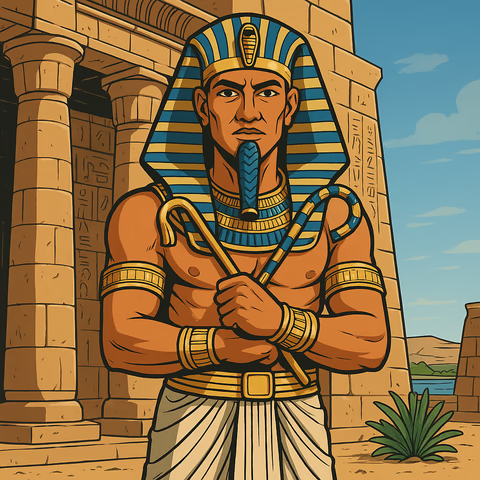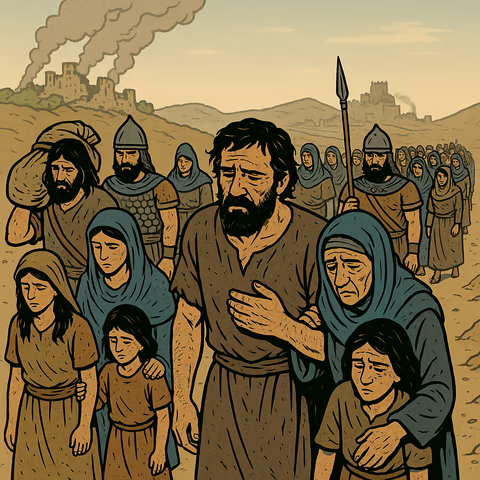
Who Was Pharaoh During the Exodus?
You’ve probably heard that Ramses II was the pharaoh of the Exodus — it’s in movies, books, and even some Bible commentaries. But what if that’s completely wrong? What if the real story is actually more interesting?
Most scholars place the Exodus around 1250 BC during Ramses II’s reign. But there’s a problem: this date completely contradicts the Bible’s internal chronology! When we actually follow the biblical timeline, we discover something remarkable — the Exodus happened much earlier, probably around 1525 BC.
Key Points
- The Exodus occurred around 1525 BC, not 1250 BC
- The Hyksos were likely the Israelites
- Ahmose I was probably the Exodus pharaoh
- The Tempest Stele describes Exodus-like events
- Archaeological evidence supports this timeline
The Traditional Problem
Here’s what most people think they know about the Exodus:
- Ramses II was the pharaoh.
- It happened around 1250 BC.
- ‘There’s no archaeological evidence’ for it.
But these assumptions are built on shaky ground. They come from scholars who started by doubting the Bible record rather than working with it. The Bible itself gives us precise chronological markers (1 Kings 6:1, Exodus 12:40-41) that point to a much earlier date.
Following the Biblical Timeline
The Bible gives us clear chronological markers:
- 480 years from the Exodus to Solomon’s temple (1 Kings 6:1)
- Solomon began building the temple in his 4th year (1 Kings 6:1)
- The Israelites spent 430 years in Egypt (Exodus 12:40-41)
- The temple construction started around 966 BC
When we work backward from these dates, we arrive at an Exodus date nearly 300 years earlier than the traditional view suggests. And that’s where things get really interesting…
The Hyksos Connection
Have you ever heard of the Hyksos? They were a mysterious group that Egyptian records tell us ruled part of Egypt during exactly the right time period. Here’s what we know about them:
- They were Semitic people from Canaan.
- They controlled the eastern Nile Delta.
- Their rule ended around 1550 BC.
- They were suddenly expelled from Egypt.
Sound familiar? It should! The parallels between the Hyksos and the Israelites are striking.
Understanding Hyksos Rule
Here’s something very telling: the Hyksos weren’t rulers of all Egypt; rather, they only governed their own people in a specific region. They controlled an area given to them by the pharaoh of Joseph’s time (Genesis 47:5-6), primarily in Avaris on the eastern side of the Nile Delta.
Even their name tells us something important. The most recent interpretation of ‘Hyksos’ is ‘Rulers of the Foreigners’ — not rulers of Egypt. This matches perfectly with the biblical account of the Israelites living separately in the land of Goshen.
When Egyptian records claim the Hyksos tried to dominate all Egypt in the mid-1500s BC, we should be skeptical. This might well be political spin to justify enslaving them and to cover up the dramatic events of the Exodus. The Bible tells us that the new king ‘who did not know Joseph’ became fearful of the Israelites’ growing numbers, saying ‘Look, the Israelite people are more numerous and more powerful than we’ (Exodus 1:8-9).
The Hyksos Legacy
The Israelites (known to Egyptians as the Hyksos) left a lasting mark on Egyptian culture. They introduced:
- Horse-drawn chariots
- Chain-mail armor
- Improved weapons and military equipment
- Metal helmets
- Composite and recurve bows
- An alphabet (as opposed to hieroglyphics)
- Laws on taxation and eminent domain
This technological and cultural influence helps explain why the Egyptians both feared and respected these ‘foreign rulers.’
The Name Jacob
As further proof that the Hyksos were really the Israelites, consider this remarkable detail: the name Jacob (meaning ‘Snatcher of the Heel’ in Hebrew) was completely unique to the biblical patriarch — no one else had this name before him. So when we find Hyksos kings wearing signet rings bearing the name ‘Jacob’ and even one called ‘Jacob-Baal’ (Lord Jacob), it’s a compelling connection to the Israelites!
The Case for Ahmose I
Recent research points to Ahmose I as the most likely pharaoh of the Exodus. Here’s why:
The Tempest Stele
Ahmose left us an incredible piece of evidence — a stone inscription known as the Tempest Stele (a stele is an upright stone slab with carved text or images, like an ancient billboard). It describes catastrophic events that mirror the biblical plagues described in Exodus 7-11:
- Unprecedented darkness (like the ninth plague, Exodus 10:21-23)
- Devastating storms (like the seventh plague, Exodus 9:18-26)
- Widespread destruction (Exodus 12:29-30)
- Mass displacement of people (Exodus 12:31-36)
Here’s the text of the Tempest Stele:
////////////// the gods expressed their discontent /////////
The gods (made?) the sky come with a tempest of (rain?); it caused darkness in the Western region; the sky was unleashed, without ///// ///// more than the roar of the crowd; ///// was powerful ////// on the mountains more than the turbulence of the cataract which is at Elephantine.
Each house, ///// each shelter (or each covered place) that they reached //////// ////// were floating in the water like the barks of papyrus (on the outside?) of the royal residence for ///////// day(s), with no one able to light the torch anywhere.
Then His Majesty said: ‘How these (events) surpass the power of the great god and the wills of the divinities!’ And His Majesty descended in his boat, his council following him.
The (people were?) at the east and the west, silent, for they had no more clothes (?) on them after the power of the god was manifested.
Then His Majesty arrived in Thebes /////// this statue; it received what it had desired. His Majesty set about to strengthen the two lands, to cause the water to evacuate without (the aid of) his (men?), to provide them with silver, with gold, with copper, with oil, with clothing, with all the products they desired; after which His Majesty rested in the palace - life, health, strength.
It was then that His Majesty was informed that the funerary concessions had been invaded (by the water), that the sepulchral chambers had been damaged, that the structures of funerary enclosures had been undermined, that the pyramids had collapsed(?) all that existed had been annihilated.
His Majesty then ordered the repair of the chapels which had fallen in ruins in all the country, restoration of the monuments of the gods, the re-erection of their precincts, the replacement of the sacred objects in the room of appearances, the re-closing of the secret place, the re-introduction into their naoi of the statues which were lying on the ground, the re-erection of the fire altars, the replacement of the offering tables back on their feet, to assure them the provision of offerings, the augmentation of the revenues of the personnel, the restoration of the country to its former state.
They carried out everything, as the king had ordered it.
The Succession Evidence
Here’s something that may surprise you: historical records tell us that Amenhotep I, (who ruled from 1525-1504 BC) had an older brother who died mysteriously before taking the throne. Could this have been during the final plague — the death of the firstborn? This detail fits perfectly with the biblical account and our chronology!
While some suggest Amenhotep I himself could have been the Exodus pharaoh, the circumstances strongly favor his father Ahmose. The timing, the Tempest Stele, and the succession story all point to Ahmose I as our most likely candidate.
1550 BC
Ahmose Becomes Pharaoh
Assumes control of Egypt and begins campaign against the Hyksos.
1540 BC
The Exodus Events
Period of plagues and Israelite departure, according to biblical chronology.
Possibly, this is when Ahmose’s firstborn son died, leaving his second son, Amenhotep, to succeed him.
1525 BC
Ahmose’s Death
End of his reign, following the dramatic events recorded in the Tempest Stele.
Archaeological Evidence
The traditional view claims there’s no evidence for the Exodus — but that’s not quite true! Recent archaeological discoveries have revealed several connections:
Physical Evidence
- Semitic settlements in the eastern Nile Delta.
- Sudden abandonment of Avaris around 1550 BC.
- Evidence of Hebrew-style cultural practices.
- Signs of hasty departure (valuable items left behind).
Written Evidence
- The Tempest Stele describing Exodus-like events.
- Records of Semitic peoples (Hyksos) in Egypt.
- References to ‘Jacob’ in royal seals and titles.
- Egyptian accounts of mass departure.
So why do so many scholars prefer the later date? It’s simple: they’re following Egyptian chronology rather than biblical chronology. But here’s the problem — Egyptian chronology has its own issues:
- Overlapping dynasties often counted as sequential.
- Gaps in the archaeological record.
- Conflicting ancient sources.
- Political motivation in ancient records.
Alternative Theories
While we believe Ahmose I is the most likely candidate, other theories exist:
- Thutmose III (c. 1479-1425 BC)
- Amenhotep II (c. 1427-1400 BC)
- Dudimose (end of 13th Dynasty)
However, these alternatives face significant chronological challenges when compared with biblical data.
Conclusion
When we examine the evidence carefully — the biblical chronology, archaeological findings, and ancient Egyptian records — Ahmose I emerges as the most likely candidate for the Exodus pharaoh. This identification:
- Aligns with biblical chronology
- Matches archaeological evidence
- Explains the Hyksos connection
- Fits with Egyptian historical records
- Makes sense of the Tempest Stele
While absolute certainty may elude us, the convergence of evidence around Ahmose I and the 1525 BC timeframe provides a compelling case that aligns with both Scripture and archaeology. The evidence increasingly supports the biblical account. The Exodus wasn’t just a story — it was a real historical event that left its mark on both Egyptian and biblical history!
Biblical Chronology
 Bible Chronology Based on the Septuagint
Bible Chronology Based on the Septuagint Who Was Pharaoh in Exodus?
Who Was Pharaoh in Exodus? How Long Were the Israelites in Egypt?
How Long Were the Israelites in Egypt? How Long Was the Babylonian Exile?
How Long Was the Babylonian Exile? When Bible Chronology Goes Wrong
When Bible Chronology Goes Wrong
Also see our Articles index and our About section.